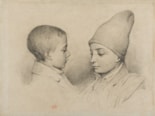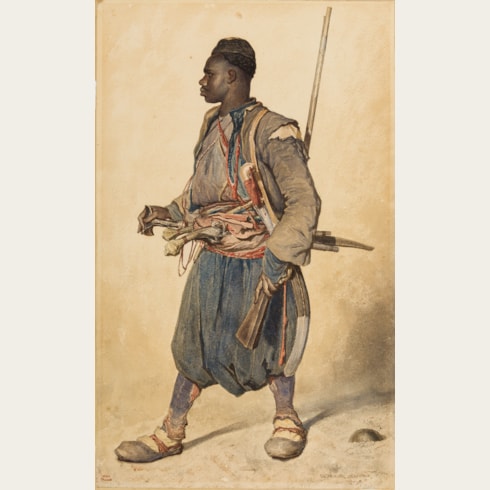Théodore VALERIO
(Herserange 1819 - Vichy 1879)
Studies of Two Young Boys
Pencil on buff paper.
Stamped with the Valerio vente stamp (Lugt 2476) at the lower left centre.
Indistinctly numbered and inscribed in pencil on the verso.
218 x 288 mm. (8 1/2 x 11 3/8 in.)
Stamped with the Valerio vente stamp (Lugt 2476) at the lower left centre.
Indistinctly numbered and inscribed in pencil on the verso.
218 x 288 mm. (8 1/2 x 11 3/8 in.)
On his travels in Eastern Europe, Théodore Valério made drawings of the many different types of people he encountered; Armenians, Jews, Ruthenians, Germans, Slavs, Slovaks and Gypsies, all of whom had kept much of their customs and traditions intact. The artist exhibited at the Paris Salons between 1857 and 1879, showing numerous paintings, drawings and etchings that brought these little-known peoples to the attention of a wider public in France. As one modern scholar has written of Valério’s drawings, ‘En même temps qu’un type, chacun de ses personnages est une portrait. La main est légère, les formes harmonieuses, la ligne pure autant que la touche franche et spirituelle. C’est une riche moisson pour la grâce comme pour l’étrangeté, avec la saveur piquante de l’inconnu.’
Of Italian origins, Théodore Valério was born in the Moselle region of eastern France, not far from the border with Luxembourg, and entered the Parisian studio of Nicolas-Toussaint Charlet in 1834. The two artists soon became friends, and in 1836 travelled together on a sketching tour of Germany, Switzerland and Italy. Valério made his public debut in 1838, at the age of nineteen, at the Salon des Artistes Vivants. He continued to exhibit at the Salons until his death, winning a third-class medal in the category of engraving in 1859. A painter, engraver and draughtsman, he produced landscapes, genre scenes and military subjects. He was an inveterate traveller, and in the 1840s and 1850s made extensive tours of Italy, Switzerland, Germany, Austria, Hungary and Romania, as well as the Balkans and Turkey. During the Crimean War Valério was attached to the Ottoman army commanded by Omar Pasha, and produced drawings and watercolours of the conflict, notably the siege of Sebastopol, as well as of the multitude of soldiers and civilians from across the Ottoman Empire who made up the Sultan’s army.
Valério made numerous drawings and studies of the exotic costumes and features of the peoples that he saw on his travels, particularly in the countries of Eastern Europe and the Austro-Hungarian empire. He was far, however, from being a pampered tourist. Travelling either on foot or horseback, and venturing far from major cities, the artist lived and dined among the rural peasantry and nomadic peoples of the region, of which he produced many insightful and sympathetic drawn portraits. These documentary works were praised by the critic Théophile Gautier, who saw Valério as an artist-ethnographer, and a large group of drawings and watercolours by the artist – mainly portraits executed on trips to Hungary and the Balkans between 1851 and 1854 - were exhibited at the Exposition Universelle in Paris in 1855, to considerable acclaim, and were purchased by the State; these are today in the collection of the Ecole des Beaux-Arts in Paris. Many of Valério’s drawings and genre scenes were also reproduced in the form of albums of lithographs or etchings, notably Les Populations des provinces danubiennes en 1854, published in Paris around 1855. Valério also published an account of his travels, entitled ‘Essais ethnographiques sur les populations hongroises’, in the magazine L’Artiste in 1858. The artist spent much of his later years in Brittany, which he had first visited in 1843, and also spent some time in England before his death in 1879. The following year, a sale of some of the contents of his studio, including sixty paintings and numerous drawings, was held in Paris.
Valério made numerous drawings and studies of the exotic costumes and features of the peoples that he saw on his travels, particularly in the countries of Eastern Europe and the Austro-Hungarian empire. He was far, however, from being a pampered tourist. Travelling either on foot or horseback, and venturing far from major cities, the artist lived and dined among the rural peasantry and nomadic peoples of the region, of which he produced many insightful and sympathetic drawn portraits. These documentary works were praised by the critic Théophile Gautier, who saw Valério as an artist-ethnographer, and a large group of drawings and watercolours by the artist – mainly portraits executed on trips to Hungary and the Balkans between 1851 and 1854 - were exhibited at the Exposition Universelle in Paris in 1855, to considerable acclaim, and were purchased by the State; these are today in the collection of the Ecole des Beaux-Arts in Paris. Many of Valério’s drawings and genre scenes were also reproduced in the form of albums of lithographs or etchings, notably Les Populations des provinces danubiennes en 1854, published in Paris around 1855. Valério also published an account of his travels, entitled ‘Essais ethnographiques sur les populations hongroises’, in the magazine L’Artiste in 1858. The artist spent much of his later years in Brittany, which he had first visited in 1843, and also spent some time in England before his death in 1879. The following year, a sale of some of the contents of his studio, including sixty paintings and numerous drawings, was held in Paris.
Provenance
Among the contents of the artist’s studio at the time of his death
The Valerio studio sale, Paris, Hôtel Drouot, 12-14 February 1880
Hazlitt, Gooden & Fox, London, in 1985
Colin Clark, London
Thence by descent.
The Valerio studio sale, Paris, Hôtel Drouot, 12-14 February 1880
Hazlitt, Gooden & Fox, London, in 1985
Colin Clark, London
Thence by descent.
Exhibition
London, Hazlitt, Gooden & Fox, Nineteenth Century French Drawings, 1985, no.15, pl.17.







